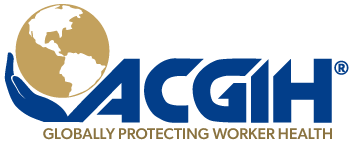- About
-
-

- About
-
ACGIH is a 501(c)(3) charitable scientific organization that advances occupational and environmental health.
-
-
- Subscriptions
-
- Science
-
-

- Science
-
This section has been established to help educate industry, government, and the public on what TLVs and BEIs are, and how TLVs and BEIs may best be used.
-
-
- Career Development
-
-

- Career Development
-
ACGIH is committed to providing its members and other occupational and environmental health professionals with the training and education they need to excel in their profession.
-
-
- Publications
-
-

- Publications
-
ACGIH has publications in many different areas that fit your needs in your field.
-
- Publications Store
- ACGIH Signature Publications
ACGIH Digital Library
If you need to purchase the Digital Library, click here.
If you have purchased and need to access the Digital Library, click here.
-
-
Webinar – SESSION 3: Toxicology Series: Genotoxicity, Carcinogenicity, & Epidemiology Data for Use in Setting Occupational Limits
Carcinogenicity of xenobiotics is associated with chemical interactions at the nuclear level. This webinar will provide an overview of the current in vitro and in vivo carcinogenicity study types used by toxicologists to determine if a xenobiotic has the potential to cause cancer.
Webinar – SESSION 2: Toxicology Series: Developmental & Reproductive Toxicity & Toxicokinetic & Toxicodynamic Considerations
An overview of the reproductive cycle and fetal development will be presented with an emphasis on the areas where chemical exposure can induce adverse effects. Standard toxicology study designs will be described as well as how the data generated from these studies are used for risk assessment purposes.
Webinar – SESSION 1: Toxicology Series: Principles of Toxicology and Basics of Inhalation Toxicology for the Industrial Hygienist
Basics of Inhalation Toxicology will help the participant to understand the anatomical, physiological, and physicochemical determinants of particle and gas deposition or absorption in the respiratory tract upon inhalation exposure, as well as broad concepts related to the fate and effects of inhaled toxicants.
Webinar – Introduction of Computational Fluid Dynamics Applied in Industrial Ventilation
This webinar will focus on how Computational Fluid Dynamic (CFD) is used in the field of Industrial Ventilation. We will show how this visual technique can be a powerful tool in ventilation design and in troubleshooting Industrial Ventilation systems.
Webinar – The Environmental Risk Assessment of Medicinal Products; Implications for Human Health
The drugs released into the environment (PIE= Pharmaceuticals Into Environment) are a source of considerable concern for the impact on environmental species but equally for the indirect consequences on human health.
Webinar – Outcome Based Learning: Strategies For Course Design, delivery, and Evaluation for Virtual Environments
The following presentation objectives will discuss adult learning principles, and describe how to make virtual training more engaging. Lastly, it will identify ANSI Z490.2 EHS training criteria.
Webinar – Human Factors: The Science of Safety
In this presentation we will briefly discuss the field of human factors and its foundational role in safety. Human factors is the discipline of reducing the chance of human error.
Webinar – Bioaerosols Exposure in the Workplace and OSHA Standards
Occupational exposure to Bioaerosols is associated with a wide range of health effects and has a significant public health impact. However, there are challenges to establishing occupational exposure limits to bioaerosols in the workplace.
Webinar – Engaging and Empowering Employees with Heat Stress Assessment
This education session will describe the use of physiological monitoring with twenty companies in maritime, construction, and general industry. The education session will include the uses and limitations of physiological monitoring as well comparison to current regulatory recommendations.
Webinar – The New Dimensions of Occupational Health – Impact of Industrial Hygiene
The objective of this presentation is to increase occupational health professionals’ awareness about this emerging situation and about the ways to deal with adequately.





